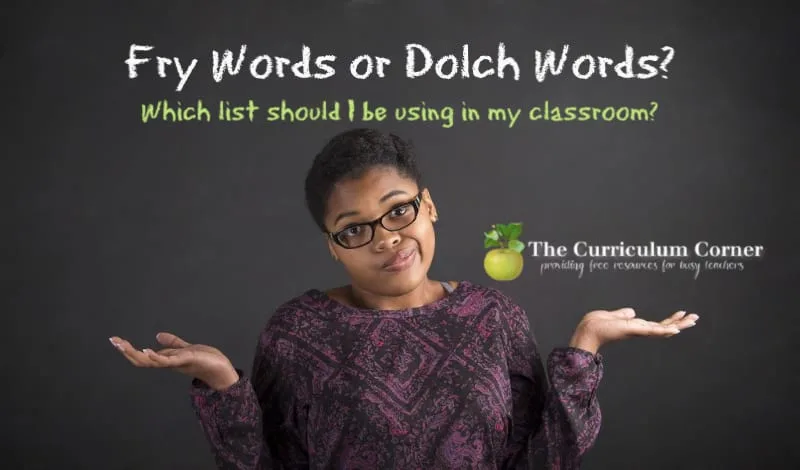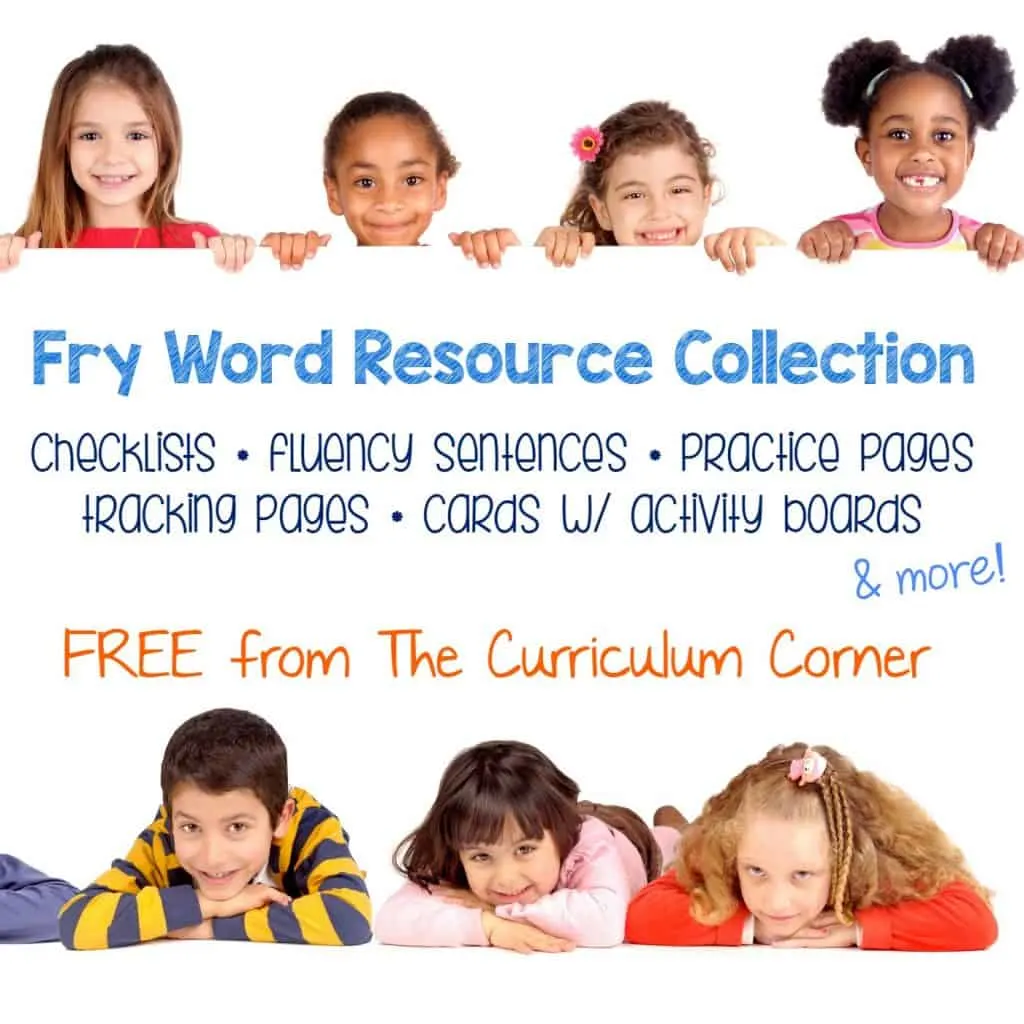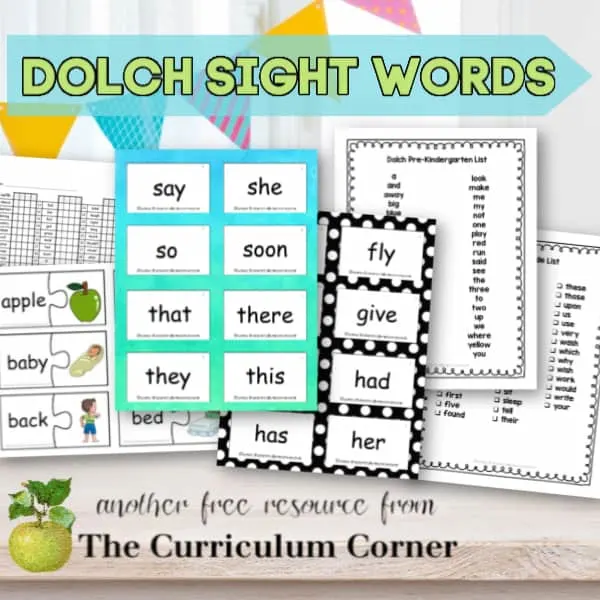Should I be using Fry Sight Words or Dolch Sight Words in My Classroom?

This is another free resource for teachers from The Curriculum Corner.
Should I be using Fry or Dolch Sight Words?
Our newest collection of Dolch Sight Word resources has resulted in quite a few questions. We are sure there are many more wondering who haven’t asked.
We have pulled together the information we have found through our own research and are sharing it in one spot.
What are high frequency words?
Before we start, we first want to address the concept of high frequency words.
The term high frequency words is used to name words that children and adults will encounter frequently in print. These words tend to be words that do not have meaning on their own. Think of words such as “a”, “the” and “and”.
These are words that we want students to know on sight. Hence the term sight words that we often hear.
Important note – there is a slight difference between the terms sight word and high frequency word. A sight word is a word known on sight when students encounter it. A high frequency word becomes a sight word for a student when they know the word on sight.
Think of high frequency words as basic facts for reading. As teachers, we know that while students can determine a math fact by counting and thinking, it is often beneficial for children to have mastery of math facts. When they are solving a multiple digit addition problem, they can focus on the skill of regrouping instead of spending time solving the basic facts involved.
Sight words are similar. Many times students can sound out the sight words and this works for early readers. However, it can slow down student reading. The choppiness of this reading can lead to comprehension loss as students spend more time decoding words than focusing on meaning.
Helping students build a base of sight words can be beneficial in helping them become better readers.
While we want students to know the words on sight, it can be challenging because of the fact that the words often lack meaning. We often use strategies such as adding pictures or actions to help students learn new words. Because the words do not have meaning on their own, we have to get creative when helping students master these words.
Just like basic facts, we realize that simply memorizing a list of words might not be engaging for all students. At The Curriculum Corner we have worked to build a collection of resources that will help you make this process better for students. You will find a range of games and centers for students to use when practicing. To benefit teachers, you will also come across a selection of tracking and assessment resources.
Our Sight Word Collection will help you start!
What is the difference between Dolch Sight Words and Fry Sight Words
The two most common lists of sight words are the Dolch Sight Words and the Fry Sight Words. First, we should recognize that Edward William Dolch is referred to as the father of sight words – it is believed that he was the first to use the term sight words.
We will begin with a little history about each list:
Dolch Sight Words
- This list was compiled by Edward William Dolch in 1936.
- Dolch created the list by finding the most common words in children’s books at the time.
- This list contains 220 “tool words” or “service words” and a separate list of 95 nouns.
- Dolch named the words tool words or service words because they are used when writing in all subject matter.
- Even thought this list is old, it still contains between 50 and 75% of all words found in print.
- The Dolch words are divided into five lists. At the time of creation, these were named according to the grade level they were intended to be memorized.
- As a result of his research on reading, he believed that ability to read would determine a child’s success academically.
“A child’s language development is, next to his character, the most important part of his school experience.”
Edward William Dolch
Fry Sight Words
- This collection was compiled by Dr. Edward Fry.
- It was first created in the 1957 and then updated in 1980.
- The Fry list contains the most common 1,000 words found in print.
- Unlike the Dolch words, the list does contain nouns.
- The first 25 words make up about 1/3 of all published text. The first 100 words make up half of all published text. The first 300 words make up 65% of all text.
- Students who have mastered all 10 Fry lists, will know 90% of all words they encounter in reading and writing.
- The words are broken into 10 groups. The first group contains the first 100 most common words, the second list contains the next 100 most common words and so on.
Obviously with more words, it will take longer for students to master the collection of Fry words. Here is the suggested break down of sight word mastery:
- 1st 100 – mastered in first grade
- 2nd 100 – mastered in second grade
- 3rd 100 – mastered in third grade
- 4th – 10th – mastered if fourth – fifth grades
- Often kindergarten teachers will focus on the first 25 to 50 words.
So now that you are familiar with the differences between the two lists, are you wondering should I be using Fry or Dolch Sight Words?
Many times the lists a school will focus on are determined by the school or district.
If you are the one who is working on determining which list is best for your school or students, we will share a few thoughts to help you.
First of all, it is important to point out that there are many overlaps between the two collections. If you choose one over the other, your students will still be building that core of words they will encounter in everyday language.
Personally, our schools focused on Fry words so this is why you will find more Fry word resources than Dolch word resources on our site. It was simply what we were most familiar with.
One benefit of choosing the Fry words over the Dolch words is consistency. You can design a program for your school that begins in kindergarten and continues through intermediate grades.
This consistency also helps families. A parent who is introduced to the term Fry words in kindergarten will then need less of an explanation when work continues in first, second and third grades.
In my own classroom, I like that the range of Fry words allowed for easy differentiation. I had second graders just learning English who I would work with on the first 25 words. I also had readers who were working above grade level. They would be interested in games I would play with my beginning readers but playing a game with words they had mastered long ago was not a good use of their time. I could switch out the words and they would be working on words that were just right for them.
Another benefit to a common list in the school is shared resources across grade levels. A third grade teacher working with a student struggling in reading might be able to meet up with a first grade teacher to brainstorm strategies for sight word mastery.
Whichever list you choose, we like the idea of common lists in a school.
Why? This allows for more sharing of ideas and resources. If you create a game for your class, you can swap with another teacher who has created one for their students. Also, we are going to bring up the term consistency again. Parents and students will become familiar with the name of the list you choose.
One last point, the Fry list is more current. While the list of Fry words was last revised in 1980, the Dolch list was created in 1936 and has not been modified since.
If it is up to you to decide which lists your students will focus on, we believe all we have read supports choosing Fry over Dolch. However, if this decision has been made for you and you will be focusing on Dolch, you are not alone. There are many overlaps and students will still be building a common base of words to help them when reading.
You will find free resources geared towards each set of words here:
As with all of our resources, The Curriculum Corner creates these for free classroom use. Our products may not be sold. You may print and copy for your personal classroom use. These are also great for home school families!
You may not modify and resell in any form. Please let us know if you have any questions.



